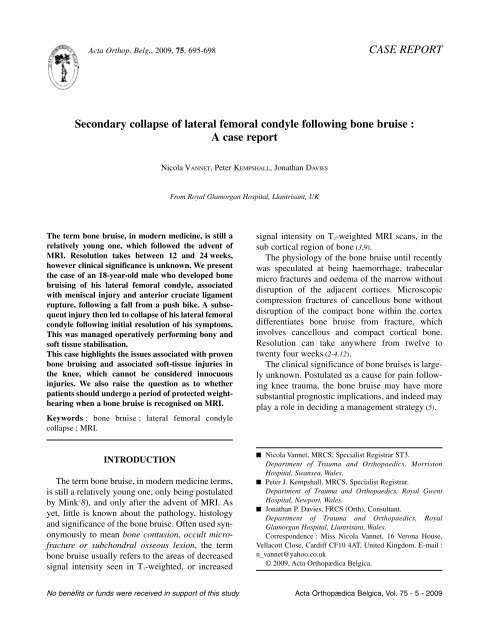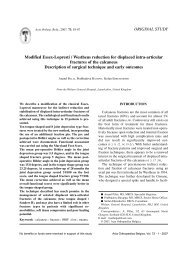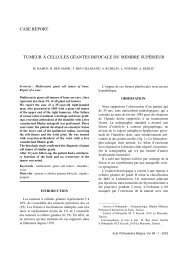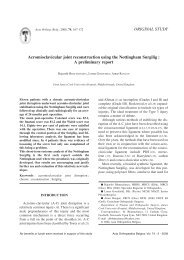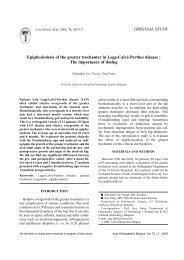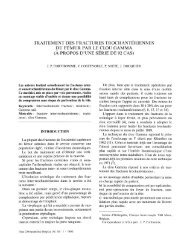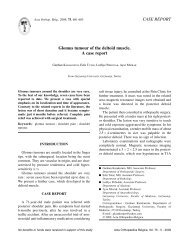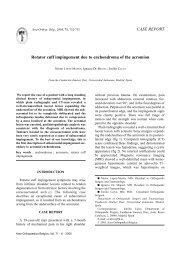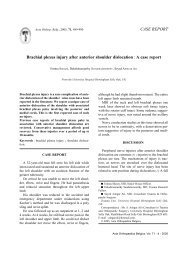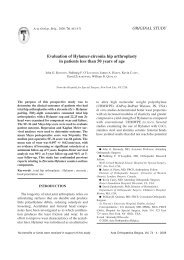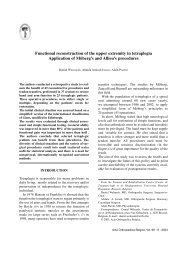Secondary collapse of lateral femoral condyle following bone bruise ...
Secondary collapse of lateral femoral condyle following bone bruise ...
Secondary collapse of lateral femoral condyle following bone bruise ...
Create successful ePaper yourself
Turn your PDF publications into a flip-book with our unique Google optimized e-Paper software.
Acta Orthop. Belg., 2009, 75, 695-698CASE REPORT<strong>Secondary</strong> <strong>collapse</strong> <strong>of</strong> <strong>lateral</strong> <strong>femoral</strong> <strong>condyle</strong> <strong>following</strong> <strong>bone</strong> <strong>bruise</strong> :A case reportNicola VANNET, Peter KEMPSHALL, Jonathan DAVIESFrom Royal Glamorgan Hospital, Llantrisant, UKThe term <strong>bone</strong> <strong>bruise</strong>, in modern medicine, is still arelatively young one, which followed the advent <strong>of</strong>MRI. Resolution takes between 12 and 24 weeks,however clinical significance is unknown. We presentthe case <strong>of</strong> an 18-year-old male who developed <strong>bone</strong>bruising <strong>of</strong> his <strong>lateral</strong> <strong>femoral</strong> <strong>condyle</strong>, associatedwith meniscal injury and anterior cruciate ligamentrupture, <strong>following</strong> a fall from a push bike. A subsequentinjury then led to <strong>collapse</strong> <strong>of</strong> his <strong>lateral</strong> <strong>femoral</strong><strong>condyle</strong> <strong>following</strong> initial resolution <strong>of</strong> his symptoms.This was managed operatively performing bony ands<strong>of</strong>t tissue stabilisation.This case highlights the issues associated with proven<strong>bone</strong> bruising and associated s<strong>of</strong>t-tissue injuries inthe knee, which cannot be considered innocuousinjuries. We also raise the question as to whetherpatients should undergo a period <strong>of</strong> protected weightbearingwhen a <strong>bone</strong> <strong>bruise</strong> is recognised on MRI.Keywords : <strong>bone</strong> <strong>bruise</strong> ; <strong>lateral</strong> <strong>femoral</strong> <strong>condyle</strong><strong>collapse</strong> ; MRI.signal intensity on T 2 -weighted MRI scans, in thesub cortical region <strong>of</strong> <strong>bone</strong> (3,9).The physiology <strong>of</strong> the <strong>bone</strong> <strong>bruise</strong> until recentlywas speculated at being haemorrhage, trabecularmicro fractures and oedema <strong>of</strong> the marrow withoutdisruption <strong>of</strong> the adjacent cortices. Microscopiccompression fractures <strong>of</strong> cancellous <strong>bone</strong> withoutdisruption <strong>of</strong> the compact <strong>bone</strong> within the cortexdifferentiates <strong>bone</strong> <strong>bruise</strong> from fracture, whichinvolves cancellous and compact cortical <strong>bone</strong>.Resolution can take anywhere from twelve totwenty four weeks (2-4,12).The clinical significance <strong>of</strong> <strong>bone</strong> <strong>bruise</strong>s is largelyunknown. Postulated as a cause for pain <strong>following</strong>knee trauma, the <strong>bone</strong> <strong>bruise</strong> may have moresubstantial prognostic implications, and indeed mayplay a role in deciding a management strategy (5).INTRODUCTIONThe term <strong>bone</strong> <strong>bruise</strong>, in modern medicine terms,is still a relatively young one, only being postulatedby Mink ( 8), and only after the advent <strong>of</strong> MRI. Asyet, little is known about the pathology, histologyand significance <strong>of</strong> the <strong>bone</strong> <strong>bruise</strong>. Often used synonymouslyto mean <strong>bone</strong> contusion, occult micr<strong>of</strong>ractureor subchondral osseous lesion, the term<strong>bone</strong> <strong>bruise</strong> usually refers to the areas <strong>of</strong> decreasedsignal intensity seen in T 1 -weighted, or increased■ Nicola Vannet, MRCS, Specialist Registrar ST3.Department <strong>of</strong> Trauma and Orthopaedics, MorristonHospital, Swansea, Wales.■ Peter J. Kempshall, MRCS, Specialist Registrar.Department <strong>of</strong> Trauma and Orthopaedics, Royal GwentHospital, Newport, Wales.■ Jonathan P. Davies, FRCS (Orth), Consultant.Department <strong>of</strong> Trauma and Orthopaedics, RoyalGlamorgan Hospital, Llantrisant, Wales.Correspondence : Miss Nicola Vannet, 16 Verona House,Vellacott Close, Cardiff CF10 4AT, United Kingdom. E-mail :n_vannet@yahoo.co.uk© 2009, Acta Orthopædica Belgica.No benefits or funds were received in support <strong>of</strong> this study Acta Orthopædica Belgica, Vol. 75 - 5 - 2009
696 N. VANNET, P. KEMPSHALL, J. DAVIESFig. 1 (A+B). — MR Imaging <strong>of</strong> the knee. T 1 and T 2 weightedimages showing the area <strong>of</strong> <strong>bone</strong> bruising in the <strong>lateral</strong> <strong>femoral</strong><strong>condyle</strong>.Fig. 2. — CT scan showing <strong>collapse</strong> <strong>of</strong> the <strong>lateral</strong> <strong>femoral</strong><strong>condyle</strong>.CASE REPORTThe <strong>following</strong> case presentation is that <strong>of</strong> an18-year-old male motorcyclist who sustained aninjury to his left knee when he fell <strong>of</strong>f his bikewhilst negotiating a corner at approx 15 mph andslid into a car.Initially no fracture was identified on plain radiographs.Subsequent review in fracture clinicrevealed an effusion, marked tenderness over themedial col<strong>lateral</strong> ligament and difficulty reachingfull extension. He was advised to mobilise pain permitting,and an MRI scan was arranged to assess theintra and extra articular ligaments around the knee.Following the MRI scan (fig 1), prior to subsequentoutpatient appointment, the swelling <strong>of</strong> theknee improved, and the boy returned to normalactivity, although he was experiencing some pain.He presented again to the accident and emergencydepartment 12 days after the MR scan with apainful swollen left knee <strong>following</strong> a subsequentminor trauma when riding a pedal cycle. Plain filmsshowed a possible depression fracture <strong>of</strong> the <strong>lateral</strong><strong>femoral</strong> <strong>condyle</strong>, this was confirmed by a CT scanwhich showed a marked depression in the <strong>lateral</strong><strong>femoral</strong> <strong>condyle</strong> (fig 2).The previous MR image, when reviewed, showeda tear <strong>of</strong> the posterior horn <strong>of</strong> the <strong>lateral</strong> meniscus,a rupture <strong>of</strong> the medial col<strong>lateral</strong> ligament (MCL),a probable rupture <strong>of</strong> the anterior crruciate ligament(ACL), and a large <strong>bone</strong> <strong>bruise</strong> in the <strong>lateral</strong><strong>femoral</strong> and tibial <strong>condyle</strong>s with no cortical depression.The patient was treated surgically, with arthroscopicassisted elevation <strong>of</strong> the <strong>lateral</strong> <strong>femoral</strong><strong>condyle</strong> under image intensifier control (fig 3).A depression in the articular surface <strong>of</strong> the <strong>lateral</strong><strong>femoral</strong> <strong>condyle</strong> was visualised at arthroscopyand measured to a depth <strong>of</strong> five millimetres. Theimpaction extended from the notch increasing progressively<strong>lateral</strong>ly. The ACL was indeed ruptured ;anterior draw, Lachman’s test and pivot shift wereall positive on examination under anaesthesia. Abucket handle tear <strong>of</strong> the <strong>lateral</strong> meniscus was alsoconfirmed. Punches were used under image intensifiercontrol through a window in the <strong>lateral</strong> femur.The aim <strong>of</strong> this presentation is to emphasise thatthe <strong>bone</strong> <strong>bruise</strong> is not necessarily an innocuous incidentallesion that can be forgotten about.ClassificationThe first classification <strong>of</strong> <strong>bone</strong> <strong>bruise</strong>s was constructedby Mink and Deutsch, who used the termoccult to mean hidden. Fractures <strong>of</strong> the marrow orarticular surface that are undetectable by conventionalradiographs become visible on MRI (8).Subsequently modified by Vellet et al, <strong>bone</strong> <strong>bruise</strong>swere divided into three categories depending ontheir position in the subcortical <strong>bone</strong> and theirActa Orthopædica Belgica, Vol. 75 - 5 - 2009
LATERAL FEMORAL CONDYLE FOLLOWING BONE BRUISE 697Fig. 3. — Image intensifier intra-operative pictures showingelevation <strong>of</strong> the depressed <strong>lateral</strong> <strong>femoral</strong> <strong>condyle</strong>.characteristic pattern. These are reticular, geographicand linear (11).DISCUSSIONImpaction fractures are not occult. They occur inconjunction with geographic subcortical fractures.They represent a depression in the articular corticalosteochondral surface. Osteochondral fractures canalso be distracted, in association <strong>of</strong> variable quantities<strong>of</strong> marrow fat. Osetochondral lesions can beeither overt or occult (11).Rangger et al studied the histopathologicalcryosectional appearance <strong>of</strong> <strong>bone</strong> <strong>bruise</strong> biopsies,taken during arthroscopy, from patients with meniscalinjuries ; they showed that the <strong>bruise</strong> was indeedmicr<strong>of</strong>ractures <strong>of</strong> the cancellous <strong>bone</strong> with oedemaas well as bleeding in the fatty marrow (10).Between the intact lamellar <strong>bone</strong> trabeculae, necrosis<strong>of</strong> the fatty marrow could also be found due toprotrusion <strong>of</strong> fragments <strong>of</strong> hyaline cartilage mixedwith highly fragmented bony trabeculae.Bone <strong>bruise</strong>s are more common that originallythought. Vellet et al studied a population <strong>of</strong>120 patients with acute post-traumatic haemarthrosisand found that 72% had occult subcorticallesions (11). This is similar to the prevalence foundby Mink and Deutsch (8). Bretlau et al found thegeneral prevalence <strong>of</strong> <strong>bone</strong> <strong>bruise</strong>s to be 56% (35 <strong>of</strong>63) when patients presenting with acute kneetrauma over a two month period to A&E were studied(3). Lynch et al found the general incidence <strong>of</strong><strong>bone</strong> <strong>bruise</strong> to be as low as 20% in a retrospectivestudy <strong>of</strong> 434 consecutive patients referred forevaluation <strong>of</strong> acute knee injury (7).Many studies have shown that the <strong>bone</strong> <strong>bruise</strong> isassociated with ligament damage in theknee (1,3,5,6). Bretlau et al reported an incidence <strong>of</strong>another lesion (ACL or MCL rupture) being presentin the knee when a <strong>bone</strong> <strong>bruise</strong> is detected on MRIto be as high as 94%. They also found that it wastwice as common to find a <strong>bone</strong> <strong>bruise</strong> on the <strong>lateral</strong><strong>femoral</strong> <strong>condyle</strong> (18 <strong>of</strong> 35 : 51%) or the <strong>lateral</strong>tibial plateau (22 <strong>of</strong> 35 ; 63%) than at similar siteson the medial side (35% and 26%) (3).There is documented evidence <strong>of</strong> the associationbetween ACL rupture with <strong>bone</strong> <strong>bruise</strong>. Thepublished prevalence is between 70-80%, Vellet etal reported 79% (11), Bretlau et al reported 67% (2).Lynch et al reported 77% (7).Bretlau also commented on the higher prevalence<strong>of</strong> <strong>bone</strong> <strong>bruise</strong>s found in total ACL rupture whencompared to partial ACL rupture (3). This is in keepingwith assumption that greater forces are requiredfor total ACL rupture. The occurrence <strong>of</strong> a <strong>bone</strong><strong>bruise</strong> with a partial ACL rupture is surprising,given the proposed pathological mechanism. It maysuggest that the patients with partial ACL injury and<strong>bone</strong> <strong>bruise</strong> experienced a greater traumatic insultand are therefore, at a greater risk <strong>of</strong> post-traumaticarthritis.The mechanism <strong>of</strong> injury to cause a <strong>bone</strong> <strong>bruise</strong>is undoubtedly complicated. Deceleration coupledwith rotation <strong>of</strong> the tibia relative to the femur, andvalgus stress are thought to be responsible for most<strong>bone</strong> <strong>bruise</strong>s. Eighty-eight percent <strong>of</strong> impactioninjuries and 62% <strong>of</strong> geographical <strong>bone</strong> <strong>bruise</strong>s werecaused by injuries producing these forces in onestudy by Vellet (11). In the case <strong>of</strong> ACL rupture, it isActa Orthopædica Belgica, Vol. 75 - 5 - 2009
698 N. VANNET, P. KEMPSHALL, J. DAVIESthe valgus force on the knee with the femur in externalrotation that causes rupture <strong>of</strong> the ACL. The <strong>lateral</strong>compartment is then able to sublux forward,tibia relative to the femur, and impact the posterior<strong>lateral</strong> lip <strong>of</strong> the tibia against the <strong>lateral</strong> <strong>femoral</strong><strong>condyle</strong>, most commonly the middle third (6,13).The <strong>bone</strong> <strong>bruise</strong> is caused by the crushing <strong>of</strong> thesubchondral <strong>bone</strong>. The force required to do thismust, therefore, damage the overlying articularcartilage. Due to the elasticity displayed by thecartilage, overt injury particularly at arthroscopymay not be immediately apparent.CONCLUSIONThis case asks the question <strong>of</strong> the significance <strong>of</strong>the <strong>bone</strong> <strong>bruise</strong>. If a <strong>bone</strong> <strong>bruise</strong> is present, be it isolatedor associated with ligament injury, a period <strong>of</strong>protected weight bearing would allow the weakenedmicro structure to heal. This case highlights theneed for this. A <strong>bone</strong> <strong>bruise</strong> has become an impactedfracture causing significant surgical morbiditythat could potentially have been avoided by simpleimmobilisation or restriction <strong>of</strong> weight bearing.REFERENCES1. Bealle D, Johnson DL. Subchondral contusion <strong>of</strong> the kneecaused by axial loading from dashboard impact : Detectionby magnetic resonance imaging. J Southern Orthop Assoc2000 ; 9 : 13-18.2. Boks SS, Vroegindeweij D, Koes BW et al. Follow-up <strong>of</strong>occult <strong>bone</strong> lesions detected at MR imaging : Systematicreview. Radiology 2006 ; 238 : 853-862.3. Bretlau T, Tuxoe J, Larsen L et al. Bone <strong>bruise</strong> in theacutely injured knee. Knee Surg Sports Traumatol Arthrosc2002 ; 10 : 96-101.4. Davies NH, Niall D, King LJ, Lavelle J, Healy JC.Magnetic resonance inaging <strong>of</strong> <strong>bone</strong> bruising in the acutelyinjures knee ; short term outcome. Clin Radiology 2004 ;59 : 439-445.5. Johnson DL, Bealle DP, Brand JC, Nyland J,Caborn DNM. The effect <strong>of</strong> geographic <strong>lateral</strong> <strong>bone</strong> <strong>bruise</strong>on knee inflammation after acute anterior cruciate ligamentrupture. Am J Sports Med 2000 ; 28 : 152-155.6. Lahm A, Erggelet C, Steinwachs M, Reichelt A.Articular and osseous lesions in recent ligament tears :Arthroscopic changes compared with magnetic resonanceimaging findings. Arthroscopy 1998 ; 14 : 597-604.7. Lynch TCP, Crues JV, Morgan FW. Bone abnormalities<strong>of</strong> the knee : Prevalence and significance at MR imaging.Radiology 1989 ; 171 : 761-766.8. Mink JH, Deutsch AL. Occult cartilage and <strong>bone</strong> injuries<strong>of</strong> the knee : Detection, classification and assessment withMR imaging. Radiology 1989 ; 170 : 823-829.9. Niall D. Bone bruising : Simply a radiological finding or aharbinger <strong>of</strong> post traumatic arthritis. Irish J Orthop Surg1999 ; 4 : 1-14.10. Rangger C, Kathrein A, Freund MC, Klestil T,Kreczy A. Bone <strong>bruise</strong> <strong>of</strong> the knee ; Histology and cryo -sections in 5 cases. Acta Orthop Scand 1998 ; 69 : 291-294.11. Vellet AD, Marks PH, Fowler PJ, Munro TG. Occultposttraumatic osteochondral lesions <strong>of</strong> the knee : Preva -lence, classification and short-term sequelae evaluated withMR imaging. Radiology 1991 ; 178 : 271-276.12. Wilson AJ, Murphy WA, Hardy DC, Totty WG.Transient osteoporosis : transient <strong>bone</strong> marrow edema ?Radiology 1988 ; 167 : 757-760.13. Wright RW, Phaneuf MA, Limbird TJ, Spindler KP.Clinical outcome <strong>of</strong> isolated subcortical trabecularfractures (<strong>bone</strong> <strong>bruise</strong>) detected on magnetic resonanceimaging in knees. Am J Sports Med 2000 ; 28 : 663-667.Acta Orthopædica Belgica, Vol. 75 - 5 - 2009


